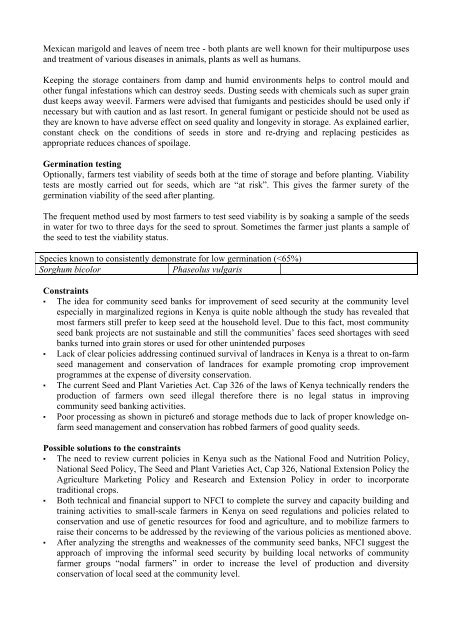Improving the identification, handling and storage of âdifficultâ seeds ...
Improving the identification, handling and storage of âdifficultâ seeds ...
Improving the identification, handling and storage of âdifficultâ seeds ...
Create successful ePaper yourself
Turn your PDF publications into a flip-book with our unique Google optimized e-Paper software.
Mexican marigold <strong>and</strong> leaves <strong>of</strong> neem tree - both plants are well known for <strong>the</strong>ir multipurpose uses<br />
<strong>and</strong> treatment <strong>of</strong> various diseases in animals, plants as well as humans.<br />
Keeping <strong>the</strong> <strong>storage</strong> containers from damp <strong>and</strong> humid environments helps to control mould <strong>and</strong><br />
o<strong>the</strong>r fungal infestations which can destroy <strong>seeds</strong>. Dusting <strong>seeds</strong> with chemicals such as super grain<br />
dust keeps away weevil. Farmers were advised that fumigants <strong>and</strong> pesticides should be used only if<br />
necessary but with caution <strong>and</strong> as last resort. In general fumigant or pesticide should not be used as<br />
<strong>the</strong>y are known to have adverse effect on seed quality <strong>and</strong> longevity in <strong>storage</strong>. As explained earlier,<br />
constant check on <strong>the</strong> conditions <strong>of</strong> <strong>seeds</strong> in store <strong>and</strong> re-drying <strong>and</strong> replacing pesticides as<br />
appropriate reduces chances <strong>of</strong> spoilage.<br />
Germination testing<br />
Optionally, farmers test viability <strong>of</strong> <strong>seeds</strong> both at <strong>the</strong> time <strong>of</strong> <strong>storage</strong> <strong>and</strong> before planting. Viability<br />
tests are mostly carried out for <strong>seeds</strong>, which are “at risk”. This gives <strong>the</strong> farmer surety <strong>of</strong> <strong>the</strong><br />
germination viability <strong>of</strong> <strong>the</strong> seed after planting.<br />
The frequent method used by most farmers to test seed viability is by soaking a sample <strong>of</strong> <strong>the</strong> <strong>seeds</strong><br />
in water for two to three days for <strong>the</strong> seed to sprout. Sometimes <strong>the</strong> farmer just plants a sample <strong>of</strong><br />
<strong>the</strong> seed to test <strong>the</strong> viability status.<br />
Species known to consistently demonstrate for low germination (

















